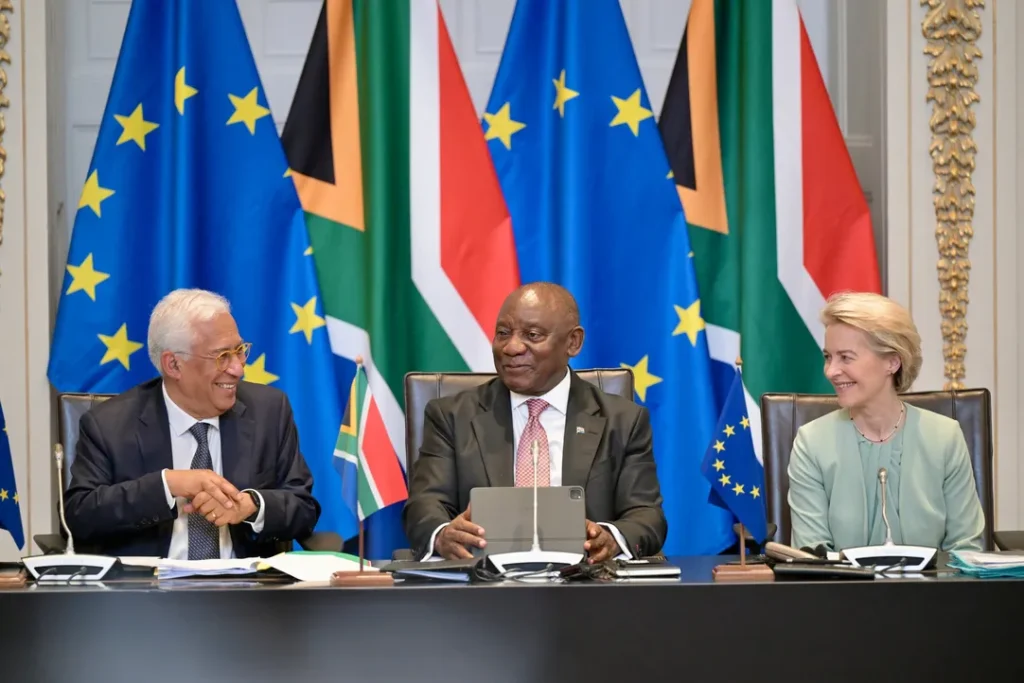EU’s €11.5 Billion Bet on South Africa Redefines Climate Finance
The EU’s €11.5 billion pledge to South Africa marks a new phase in climate-finance diplomacy. If effectively deployed, it could compress bond yields by up to 60 bps, strengthen the rand (USD/ZAR ≈ 18.9), and turn energy transition risk into an investable frontier asset.

The European Union’s €11.5 billion commitment to finance South Africa’s energy and transport sectors marks a strategic recalibration in global climate finance. Beyond development optics, it represents a test of how advanced economies can deploy capital into frontier-market transition projects without distorting sovereign risk pricing. South Africa’s Just Energy Transition Investment Plan (JET-IP), launched in 2021 with an initial USD 8.5 billion pledge, struggled with disbursement and coordination. The new EU package—part grants, part concessional loans, part guarantees—aims to accelerate implementation and stabilize the country’s investment narrative after years of fiscal and energy volatility.
For markets, the magnitude matters less than the signal. South Africa’s 10-year benchmark yield (ZAR2035 ≈ 9.1 percent) trades at a 470-basis-point premium over the U.S. 10-year (US10Y ≈ 4.35 percent), reflecting both credit and energy-transition risk. If even half of the EU facility is deployed on schedule, the implied compression in sovereign spreads could lower borrowing costs by 30–60 basis points—translating to roughly R15 billion in annual fiscal savings. The rand (USD/ZAR ≈ 18.9) remains volatile but supported by the prospect of hard-currency inflows, while euro-denominated funding partially hedges South Africa’s external-debt profile.
The structure mirrors global precedents. Indonesia’s USD 20 billion JET-P achieved a blended cost of capital of about 3.8 percent, compared with an estimated 6 percent in South Africa. Egypt’s USD 10 billion Green Corridor program, financed through the European Investment Bank (EIB) and the African Development Bank (AfDB), achieved disbursement efficiency of 70 percent within 18 months. Replicating that performance would mark a step change for Pretoria’s execution capacity. With public debt near 74 percent of GDP and fiscal deficits around 4.7 percent, any concessional inflow that alleviates domestic borrowing can reprice the sovereign curve.
The pledge also reframes the rand’s macro narrative. South Africa’s energy insecurity has long been a structural drag on productivity and inflation expectations. A credible infusion of euro-denominated capital for renewable generation and logistics upgrades strengthens both the current-account outlook and foreign-exchange reserves, now around USD 55 billion. A 1 percent improvement in energy reliability could raise GDP growth by 0.3 percentage points annually—small but material in a 1–2 percent baseline economy.
Globally, the commitment signals that ESG capital is pivoting toward risk-linked returns rather than grants. The EU’s blended-finance model reduces default probability through multilateral guarantees while preserving yield for private investors. For ESG-focused funds like iShares ESG Aware MSCI EM (NASDAQ: ESGE) and frontier-market ETFs such as iShares Frontier & Select EM (NYSEARCA: FM) or VanEck Africa Index (NYSEARCA: AFK), South Africa’s transition debt may offer a benchmark for integrating climate performance metrics into sovereign-bond indices.
Execution, however, will determine credibility. South Africa’s track record with the USD 8.5 billion JET-IP shows just 48 percent disbursement by mid-2025 due to regulatory and coordination bottlenecks. The EU facility’s success depends on project vetting, grid modernization, and transparent procurement. If governance falters, concessional funds risk being reclassified as sovereign liabilities, eroding fiscal headroom instead of expanding it.
Still, the pledge changes the narrative. It demonstrates that global capital can price African transition risk not as charity but as investable yield. With Brent crude (ICE: LCOc1) near USD 85 per barrel, and global clean-energy investments exceeding USD 2 trillion annually, Africa’s carbon-transition assets are becoming a legitimate component of institutional portfolios. For Europe, this engagement is both climate policy and energy diplomacy—anchoring long-term LNG and renewables access through strategic finance.
If implemented effectively, the €11.5 billion commitment could become a template for how frontier markets absorb climate capital at scale—measured not in press releases but in basis points saved. South Africa’s fiscal story, long dominated by Eskom’s deficits and bond-market caution, may finally pivot toward an investment-driven narrative. The country’s next yield curve will not be written in budget speeches alone, but in how credibly it converts foreign pledges into functioning megawatts and exportable carbon credits.





